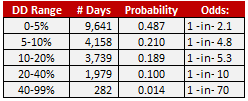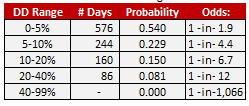The sucker at the craps table was me – and I loved every minute of it.
I remember the very first time I went to Las Vegas. I was in my late 20s, and I had just wrapped up a business trip to L.A. I planned to spend three days in Vegas, and I believed that I had an above-average chance to leave there a winner. This wasn’t just a fun-filled getaway for me. I took this adventure seriously.
I was by myself, intentionally, because I didn’t want any distractions. I wasn’t interested in sight-seeing trips to the Hoover Dam, or taking in a show or two. I was there for one purpose – to gamble.
Over the three days, I lost most of my $1,500 stake. But I fought like a warrior to stay in the game as long as I could. I almost missed my plane because I was still at the Craps table when my cab arrived.
What I got for my $1,500
Of course I was disappointed to come home a loser, but there was something very valuable that I learned from the experience. There was a dealer who took a liking to me, and sort of took me under his wing a little. I had read a few books about gambling before the trip, but being on the line of fire is an entirely different thing.
Craps is a fast-moving game. There’s no time to stop and think about what you should do next. No time to recall what the books said about betting odds. You have to go with your gut. This is where the friendly dealer helped me the most.
After I was at the table for 20 minutes or so, he could easily recognize that I was an amateur. He could have taken advantage of this fact, but he went the other way. He began to advise me about the bets I was making, and telling me when I was making a sucker bet. By the end of the first night, he was telling me what numbers to bet on, and how much, and he was incredibly accurate.
That night, back in my room, I couldn’t figure out why this guy, who worked for the casino, would be giving me betting tips that actually helped me, and by inference hurt the casino. I didn’t have an answer, but I decided to seek him out when he came on shift the next day.
I found out a few years later that it’s common practice for dealers to befriend amateurs and help them along. It’s good for business, because a rookie gambler like me is much more likely to return to that casino if he was treated well.
For a fee of $1,500, I received a first class education in the fine art of calculating odds and managing bet size. My tuition was very well-spent.
What I did with my degree
At the time, I had been working in the investment business for about 5 or 6 years, but only in a back-office, or admin capacity. My Vegas experience inspired me to find a way to get myself into a position where the real action was happening – the trading desk. I figured that in order to be a successful trader, you would have to be good at assessing the odds of winning when an opportunity came along.
About a year after my trip, I heard about a new trading operation that was about to start up. It would be headed by Owen Hill, who was viewed by the partners in the firm as a trading savant of sorts. He was whip-smart, a little eccentric, and had lots of big money clients. The partners gave him carte blanche to build an arbitrage trading desk, and they seeded it with firm capital. I knew right away that this was a golden opportunity to get in on the ground floor of something that could be really outstanding.
I managed to wrangle an interview with Owen, and luckily the chemistry was good. A couple of weeks later, he hired me and two other rookies, along with a seasoned analyst. The five of us were about to embark on a new adventure with unlimited promise. And we succeeded beyond our expectations.
Why betting odds are so important in investing
Accomplished gamblers reduce their bets when the odds of winning are low. Accomplished investors do the same thing. In Vegas, this is called bet management. In the stock market, it’s called asset allocation.
Suppose you are in your late 30s or early 40s, and you have built up a nice little nest egg over the years. Naturally, you want to protect your nest egg as much as you can. But you can’t just put it all in Treasury Bills, because it won’t grow fast enough. So you put 80% into the stock market, and 20% into 10 Yr Treasury Bonds.
How valuable would it be if you could know what the odds are that a bear market will hit, sometime in the next 12 months? Most investors would say that would be quite valuable. But is it possible? Yes. Knowing the odds doesn’t guarantee that things will play out in a certain way, but they tell you the likelihood of something happening. That’s valuable information to have, wouldn’t you agree?
If you knew, with a high degree of confidence, that a bear market was likely to hit within the next 12 months, what would you do with that information? Many investors would do nothing, because they have been told over and over again by experts that it’s impossible to time the market, and buy & hold is the best way to go.
But some investors, including all of my coaching clients, would take steps to protect their nest egg. The most risk-averse among them might reduce their equity exposure from 80% to 50% right away. Others might cut back to 70%, and wait for more information. The way you go about playing defense when a bear market is a clear and present danger, depends on your risk preferences, your age, and your financial resources.
Here are the odds of a bear market coming sometime within the next 12 months
The “base rate” probability of a bear market coming within any 12-month period is 11.4%. The data is shown in this table.
That’s the base line. Now we introduce a new variable that is known to have influence over the likelihood of bear markets arriving: New Highs. When the market makes a new high, it’s a big deal. Since 1941, there have only been 1,066 new highs recorded. That works out to 5.4% of all trading days.
Our base rate probability of a bear market doesn’t take new highs into account. But we can easily do this by adjusting the base rate accordingly. In the next table, we look at only those days where a new high was made. We then look ahead 12 months, and calculate the maximum DD.
We get a very different picture when we narrow our focus to just new high days. The odds of a bear market within the next 12 months drops from 11.4% to 8.1%. This seems to contradict the widespread belief that when the market makes a new high, the chances of a bear market will increase. The data says otherwise.
How to use this information
This is what I tell my coaching clients. The base rate risk of a bear market happening within 12 months of any given day is 11.4%. This means that you are willing to make the maximum bet on risk assets like stocks, because the odds are nearly 9-1 against a bad outcome. That’s rational, and a smart way to look at asset allocation.
And, if the market is making new highs, as it is today, the odds of a bear market go down. So it’s even smarter and safer to stay fully invested in stocks than it usually is.
There are many other factors that influence the odds of a bear market
We have only scratched the surface in our quest to find guidance about when to stay fully invested, and when to begin pulling back. There are other factors at play. Recessions, dips, corrections, valuations, to name a few. We will cover all of them in future installments of this series.


